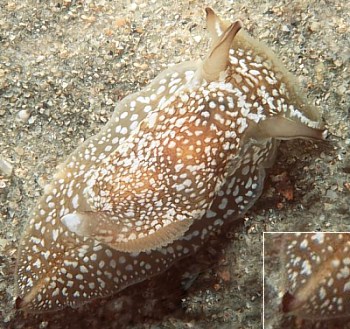
Pleurobranchaea inconspicua?
Bergh, 1897
Order: NOTASPIDEA
Superfamily: PLEUROBRANCHOIDEA
Family: Pleurobranchidae
DISTRIBUTION
West Atlantic - Cape Hatteras to Argentina.
West Africa - Ivory Caost to Nigeria.
PHOTO
West Palm Beach, Florida, USA, Depth: 15 feet. February, 2001. Approx 2 inches [5cm] long. Photo: Anne DuPont
See discussion below about problems identifying this species.
References:
• Marcus, E. & Gosliner, T.M. (1984) Review of the family Pleurobranchaeidae (Mollusca, Opisthobranchia). Annals of the South African Museum, 93(1): 1-52.
Rudman, W.B., 2001 (August 20) Pleurobranchaea inconspicua? Bergh, 1897. [In] Sea Slug Forum. Australian Museum, Sydney. Available from http://www.seaslugforum.net/find/pleuinco
Related messages
Pleurobranchaea inconspicua from Cozumel, Mexico
March 4, 2005
From: Jim Lyle
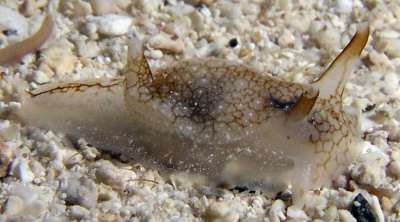
Here's an image of Pleurobranchaea inconspicua Bergh, 1897 taken on a night dive off the coast of Cozumel Island, Mexico. It differs from the image posted by Anne DuPont [message #5115 ], having a netted pattern rather than spots on the mantle.
Locality: Cozumel Island, Quintana Roo, Mexico, Caribbean. Depth: 5 meters. Length: 12 mm. 08 August 2004. sand. Photographer: Margaret Webb.
Jim Lyle
jlyle@scubadiving.com
Lyle, J.L., 2005 (Mar 4) Pleurobranchaea inconspicua from Cozumel, Mexico. [Message in] Sea Slug Forum. Australian Museum, Sydney. Available from http://www.seaslugforum.net/find/13265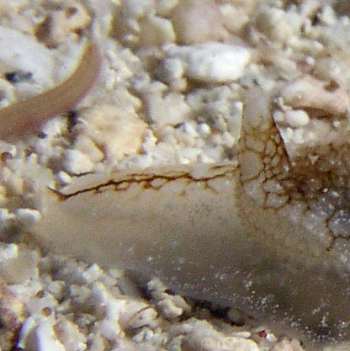
Dear Jim,
Your photo looks very like Dave Behren's photo [message #8155] from Belize. It certainly is a species with a caudal spur [spine on tip of foot]. As I said in earlier comments, this form seems to fit P. hedgpethi which is considered a synonym of P. inconspicua. I guess what we need to do now is to compare the anatomy of animals of each of the two colour forms, and to try and find some intermediate colour forms. Which is the sort of thing we need to do with most species of Pleurobranchaea.
Best wishes,
Bill Rudman
Pleurobranchaea hedgpethi from Belize
October 14, 2002
From: Dave Behrens
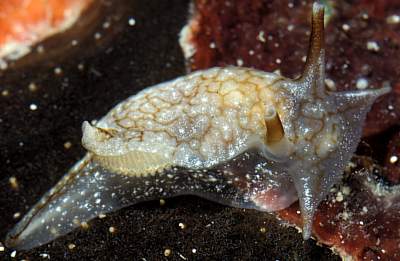
Dear Bill,
Attached is another species from the Caribbean to add to the Forum. This I believe to be Pleurobranchaea hedgpethi.
The specimen was collected on a night dive at Nicholas Cut, Belize, Central America by Jeff Hamann.
Dave Behrens
dave@seachallengers.com
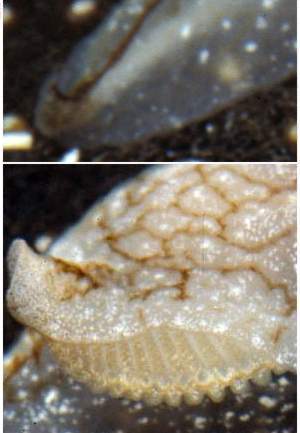
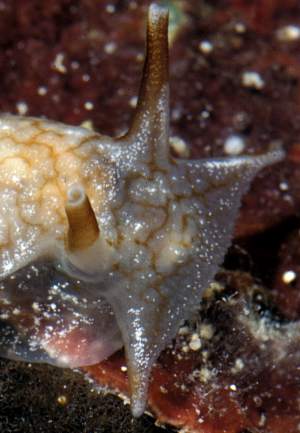
Thanks Dave,
Pleurobranchaea hedgpethi was originally described (Abbott, 1952) from a preserved specimen from Texas, approx 40mm long preserved. In life it was reported to be 'sepia brown with lighter mottlings". As I discuss in reply to Anne DuPont's message from Florida, Marcus & Gosliner (1984) consider P. hedgepethi to be a synonym of P. inconspicua. In your animal the brown reticulate pattern seems to be more obvious than in the Florida animal, and the white patches less obvious. Both have a brown median line on the posterior foot and a caudal spur. From my experience of Pacific species, the colour pattern of species of Pleurobranchaea are quite variable.
• Abbott, R.T. (1952) Two new opisthobranch mollusks from the Gulf of Mexico belonging to the genera Pleurobranchaea and Polycera. Florida State University Studies, 7: 1-7.
Best wishes,
Bill Rudman
Re: Pleurobranchaea cf. inconspicua
August 28, 2001
From: Sandra Millen
Hi Bill,
Concerning the identity of Anne DuPont's Pleurobranchaea I found that Abbott's book American Seashells gives the coloring for P. hedgpethi (which he described) and which is now a synonym of P. inconspicua. I used the presence of a spur and finely fimbriated frontal veil to eliminate the others. Color was known for a few. Best I could do without a specimen (as you well know).
Sandra
millen@zoology.ubc.ca
Millen, S., 2001 (Aug 28) Re: Pleurobranchaea cf. inconspicua. [Message in] Sea Slug Forum. Australian Museum, Sydney. Available from http://www.seaslugforum.net/find/5155Thanks Sandra,
Looks like you and I were both handicapped by the less than clear, rather ambiguous, original descriptions. I was hoping that you had found a reference unknown to me or dissected a specimen.
Best wishes,
Bill Rudman
Pleurobranchaea inconspicua? from Florida
August 22, 2001
From: Anne DuPont

Hi Bill,
I know you have a backlog of notes, and I hate to burden you with another note, but just had to share this side-gill slug with you. Sandra Millen has identified it for me as Pleurobranchaea inconspicua Bergh, 1897
West Palm Beach, Florida, USA, Depth: 15 feet. February, 2001. Photo: Anne DuPont
Size: UPPER: Animal aprox. 2 inches long.
[Inset showing spur on posterior tip of foot]. LOWER: The two with eggs were about 1 inch long.
I include these comments from Sandra Millen:
"The side gill slug is Pleurobranchaea inconspicua Bergh, 1897. Its synonoms are P. hedgpethi & P. gela. It is a Pleurobranchaea because its rhinophores are far apart (not together at the base) and it is interesting because the veil has tiny frimbulations, the mantle has a siphon at the back and the tail has a posterior spur, all of which can be seen in your photo."
[Sandra Millen,
Department of Zoology,
University of British Columbia,
Vancouver, B.C., Canada, V6T 1Z4
millen@zoology.ubc.ca]
Best wishes,
Anne DuPont.
adupont@gate.net
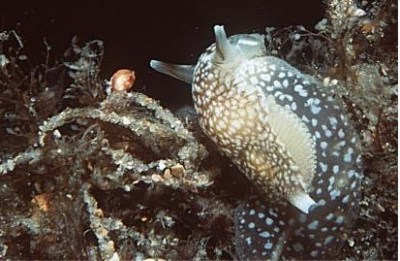
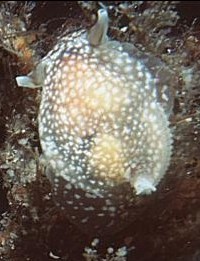
Dear Anne,
Don't ever hesitate to send messages. Although I have a growing backlog I always have time for new and interesting material. As I think I mentioned with your recent message about the Hypselodoris from Florida, every time I try and research a species from the Caribbean I discover an almost total lack of information. This Pleurobranchaea is a case in point. I can find no description of a west Atlantic species with this very distinctive colour pattern of large opaque white spots. In fact there is no good colour description of any west Atlantic species of Pleurobranchaea, most being described from preserved material. Abbott (1952) noted in his description of P. hedgepthi, which is considered a synonym of P. inconspicua, that:
"Mr Hedgepeth recalls that in life they were sepia brown with lighter mottlings".
I don't know if the white spots on the animal you have photographed could be sensibly described as having 'lighter mottling' but it does illustrate the difficulty in identifying these species.
Marcus & Gosliner (1982) list the following species which have been recorded from the Florida region.
• P. tarda Verrill [= occidentalis] - sometimes has a short spur on tail but often without spur; live animal has brown and translucent clear mottlings; oral veil with many papillae
• P. agassizi Bergh, 1897 - nothing known of living colour; has spur on tail
• P. inconspicua Bergh, 1897 [= P. hamwa, P. hedgepethi, P. gela] - spur on tail; no unambiguous colour information
• P. bonnieae Marcu & Gosliner, 1984 - Described as new from one preserved animal, perhaps juvenile specimen - no information on living colour or shape.
Not a lot to go on. It seems from Marcus & Gosliner's revision that there are reasonable anatomical differences between species. Perhaps Sandra has looked at the anatomy of your white-spotted animals. If not, it would seem a very useful thing to do, because if we knew the anatomy of the animal with this characteristic colour pattern, it should be possible to match it with one of the species reviewed in Marcus & Gosliner.
References:
• Abbott, R.T. (1952): Two new opisthobranch mollusks from the Gulf of Mexico belonging to the genera Pleurobranchaea and Polycera. Florida State University Studies, 7: 1-7.
• Marcus, Er. & Marcus, Ev. (1967) American opisthobranch mollusks. Part 1, Tropical American opisthobranchs. Studies in Tropical Oceanography, Miami, 6(1-2): 1-137. (Figs 1-150, Pl.1, figs 1-9).
• Marcus, E. & Gosliner, T.M. (1984) Review of the family Pleurobranchaeidae (Mollusca, Opisthobranchia). Annals of the South African Museum, 93(1): 1-52.
By the way I can't see the egg masses you mention. Are they the curved string-like objects in the lower left photo?
Best wishes,
Bill Rudman
